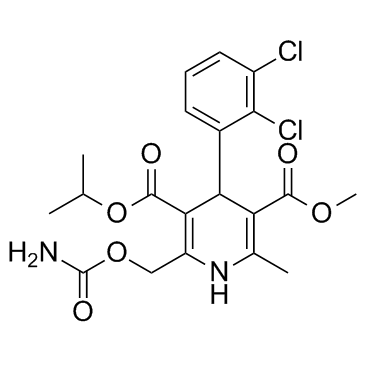94739-29-4
| Name | 3,5-Pyridinedicarboxylic acid, 2-[[(aminocarbonyl)oxy]methyl]-4-(2,3-dichlorophenyl)-1,4-dihydro-6-methyl-, 5-methyl 3-(1-methylethyl) ester |
|---|---|
| Synonyms |
LEMILDIPINE
NB 818 NPK 1886 3-Isopropyl 5-methyl (±)-4-(2,3-dichlorophenyl)-1,4-dihydro-2-(hydroxymethyl)-6-methyl-3,5-pyridinedicarboxylate, carbamate (ester) Lemildipine |
| Description | Lemildipine is a new dihydropyridine calcium entry blocker. |
|---|---|
| Related Catalog | |
| Target |
Calcium entry[1] |
| In Vivo | Gerbils are treated intraperitoneally with Lemildipine (0.1-3 mg/kg) just after release of the occlusion. Four days after the ischemia, they are fixed by perfusing 10% buffered-formalin, and the neuronal cell density (NCD, cell/mm) in the CA1 subfield is estimated under microscopy. The average NCD in the ischemic control group is 43±10.8 cells/mm, whereas Lemildipine (3 mg/kg) significantly ameliorates DND with an average NCD of 143±24.2 cells/mm (P<0.01). In addition, Lemildipine (3 mg/kg) significantly inhibits delayed neuronal death (DND) at 1, 2 and 4 weeks after transient ischemia: the average NCD of the Lemildipine and ischemic control groups are 80±9.4 (P<0.01) and 43±7.7 cells/mm, 92±13.7 (P<0.05) and 52±9.3 cells/mm, and 57±5.0 (P<0.01) and 43±12.4 cells/mm, respectively. In this experiment, Lemildipine (NB-818) exhibits a protective effect on DND in the hippocampal CA1 subfield after transient forebrain ischemia, and its effect persisted for up to 4 weeks[1]. In normal Wistar rats (NWR), Lemildipine (NPK-1886) in doses of 3-30 mg/kg, p.o., produces a mild lowering of blood pressure. The depressor effect of Lemildipine is much the same as that of Nifedipine. In contrast, Lemildipine produces a significant decrease in the blood pressure of spontaneously hypertensive rats (SHR). Oral administration of Lemildipine in doses of 3, 10, 30 mg/kg produces a significant decrease in systolic blood pressure dose-dependently. The maximum decrease is observed 1-3 hr after administration. Comparing the hypotensive potency of Lemildipine and Nifedipine, their dose-response curves at the maximum response during the observation (for 24 hr) are analyzed by the least squares method, and the dose of 30% decrease in blood pressure from the control level (ED30) are used as a measure of their potency. Lemildipine is 1.4 times stronger than Nifedipine; the ED30 values of Lemildipine and Nifedipine are 10.2 mg/kg and 14.3 mg/kg, respectively[2]. |
| Animal Admin | Gerbils[1] Male Mongolian gerbils, weighing 50-80g, are used in this experiment. Lemildipine (3 mg/kg) or vehicle is administered intraperitoneally just after the recirculation. At 1, 2 or 4 weeks after ischemia, the animals are sacrificed, and the protective effect of Lemildipine (NB-818) is examined. Mice and Rats[2] Normal Wistar rats (NWR) and hypertensive model rats (spontaneously hypertensive rats (SHR), renal hypertensive rats (RHR) and DOCA-saline-induced hypertensive rats (DOC-Na-R)) of the male sex, weighing from 250 to 350 g, are used. Oral administration of Lemildipine in doses of 3, 10, 30 mg/kg for normal Wistar rats (NWR). Lethal dose of Lemildipine and Nifedipine is determined by the Litchfield-Wilcoxon method from the data of experiments using healthy mice and rats. Mice (male and female) weighing 20±2 g and male rats weighing from 150 to 220 g are used. These two kinds of animals are fed on solid food (Crea, CA-1) and water ad lib. The animal room temperature and humidity are controlled at 22±2°C and 55±5%, respecttively. No food except water is administered 24 hr before starting the experiments for oral administration of drugs. |
| References |
| Density | 1.335±0.06 g/cm3 (20 °C, 760 mmHg) |
|---|---|
| Boiling Point | 585.6±50.0 °C (760 mmHg) |
| Molecular Formula | C20H22Cl2N2O6 |
| Molecular Weight | 457.30400 |
| Exact Mass | 456.08500 |
| PSA | 116.95000 |
| LogP | 4.45730 |
| Storage condition | 2-8℃ |
